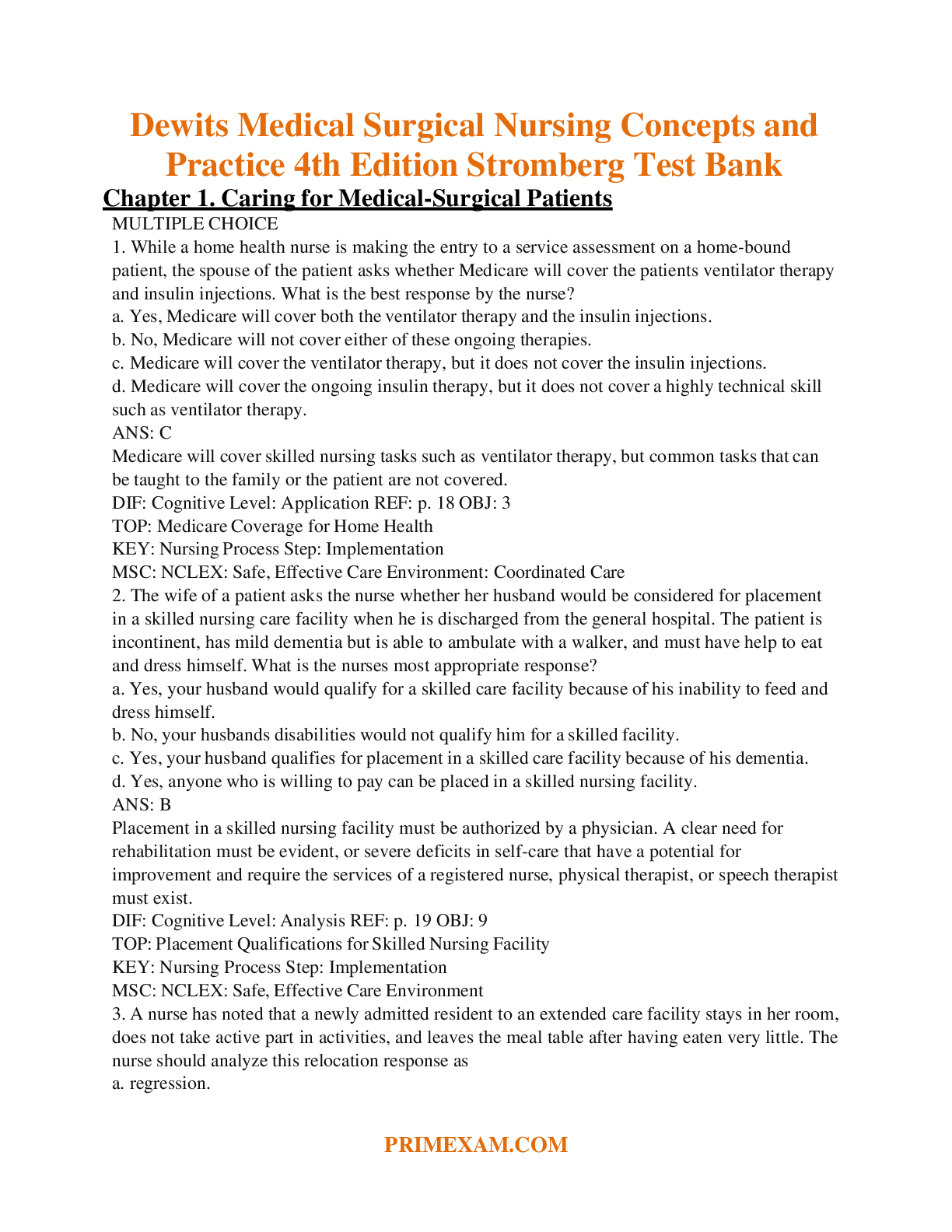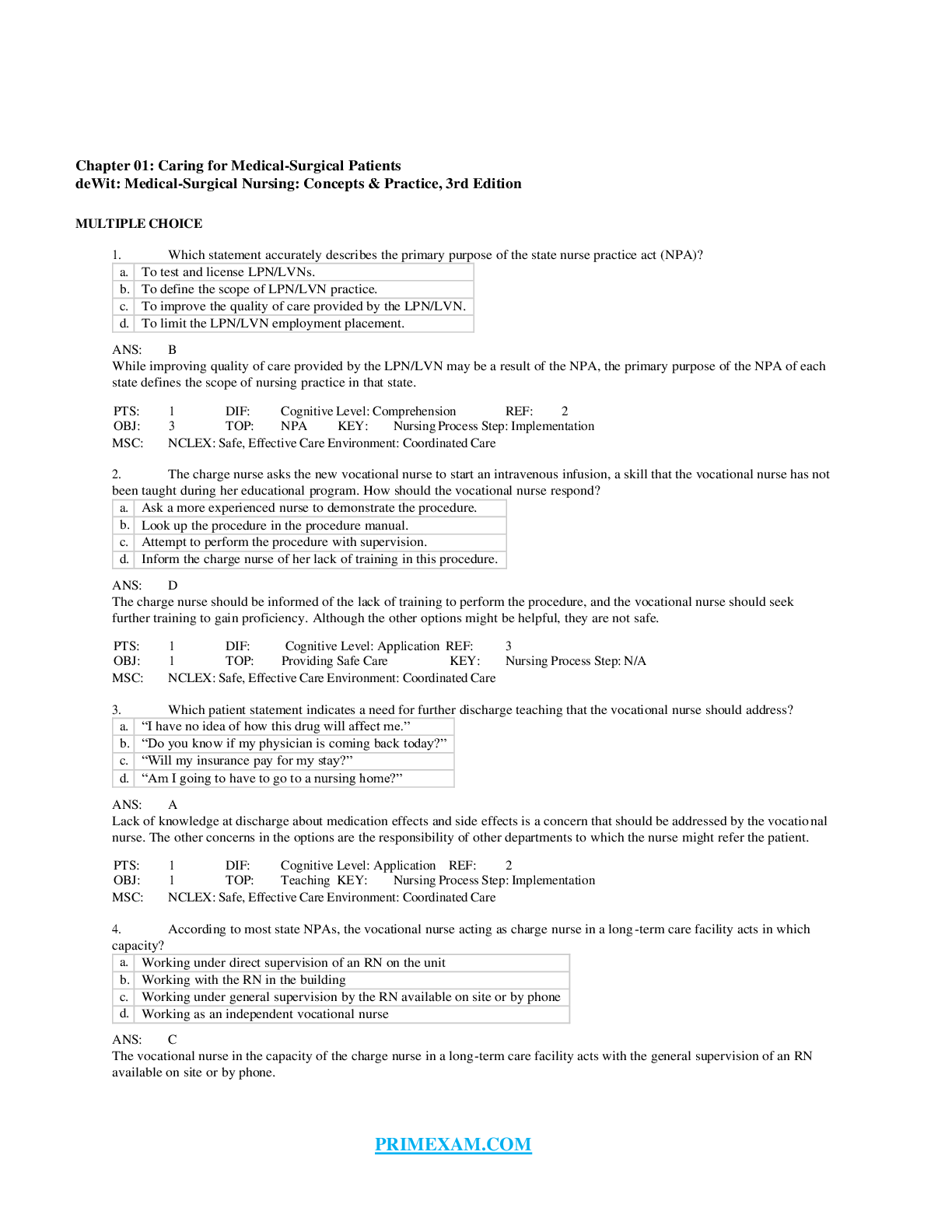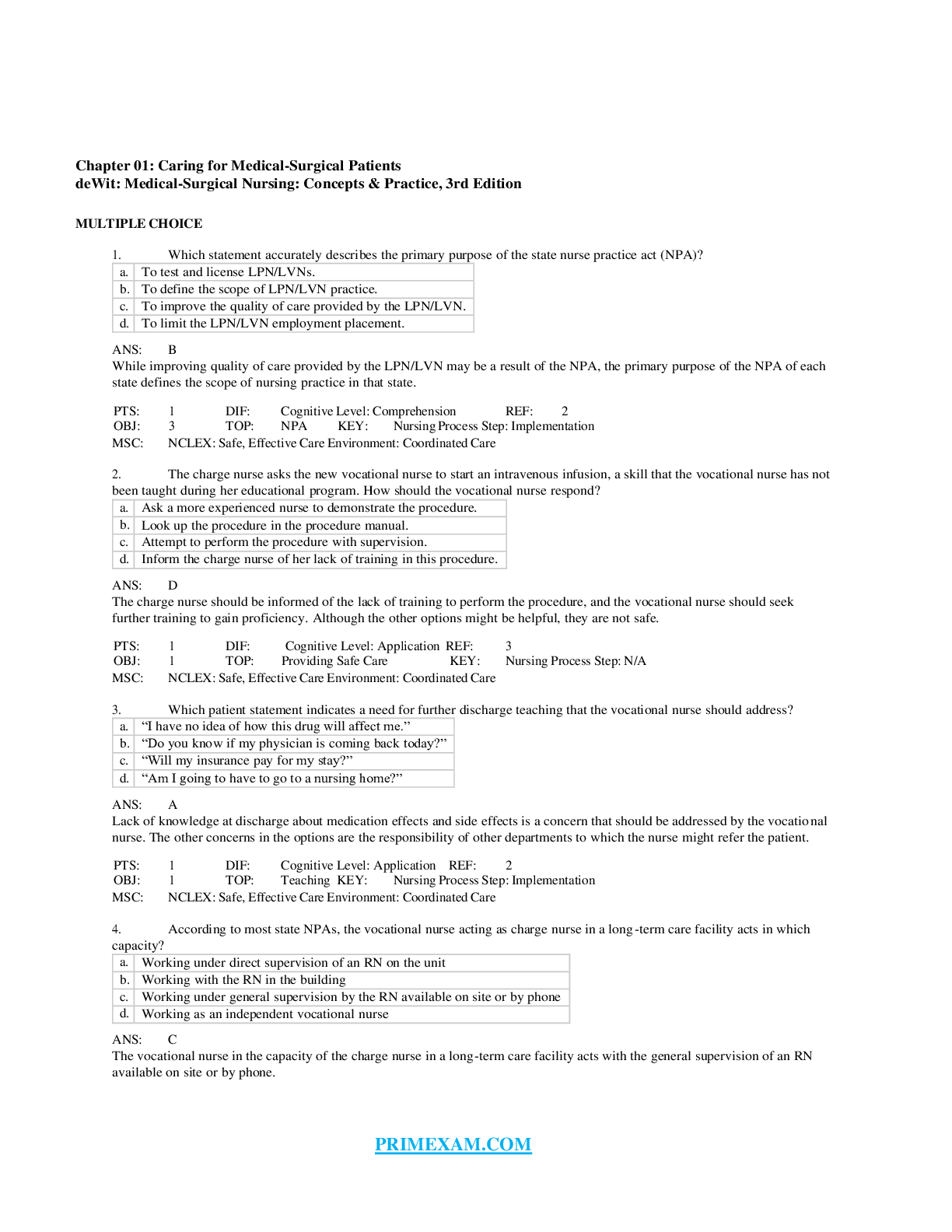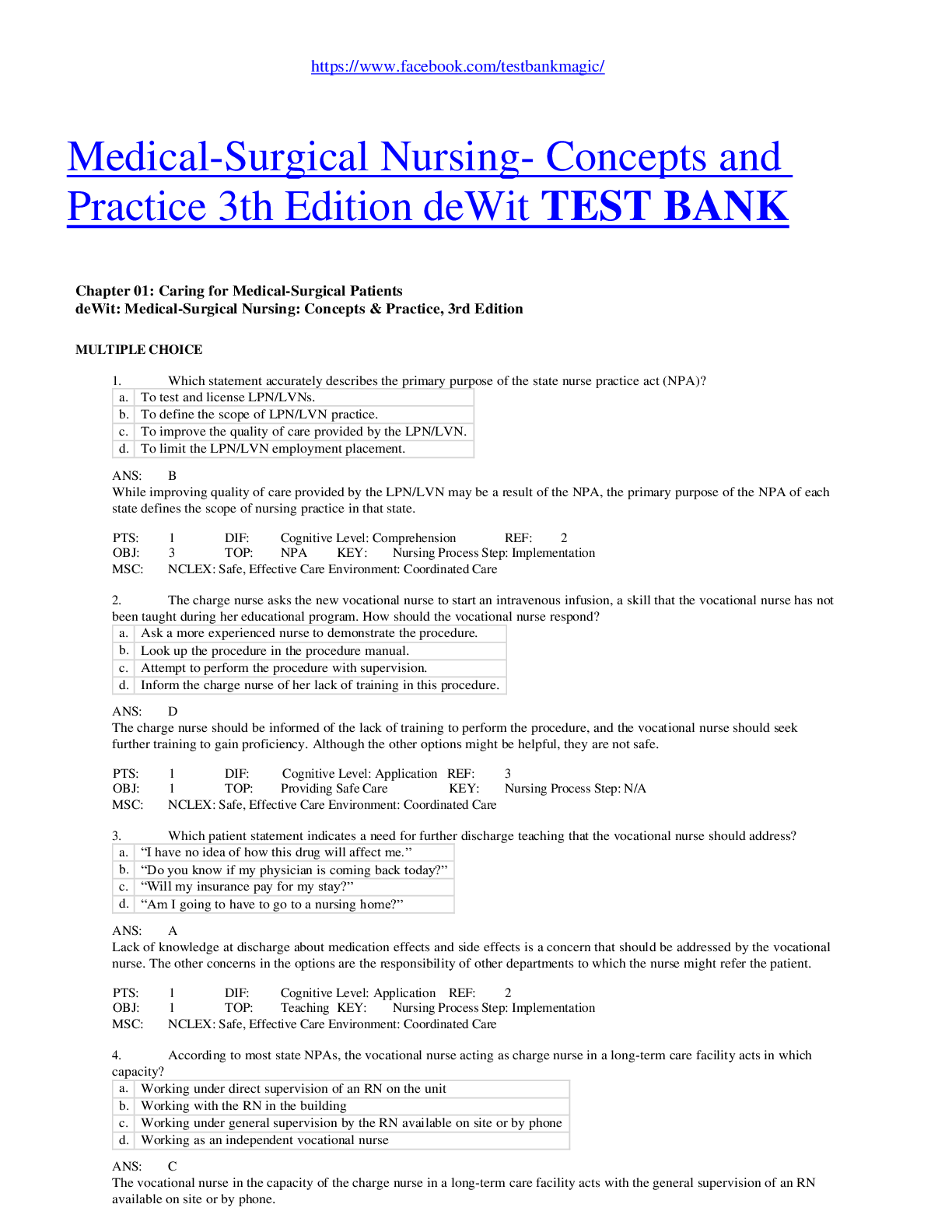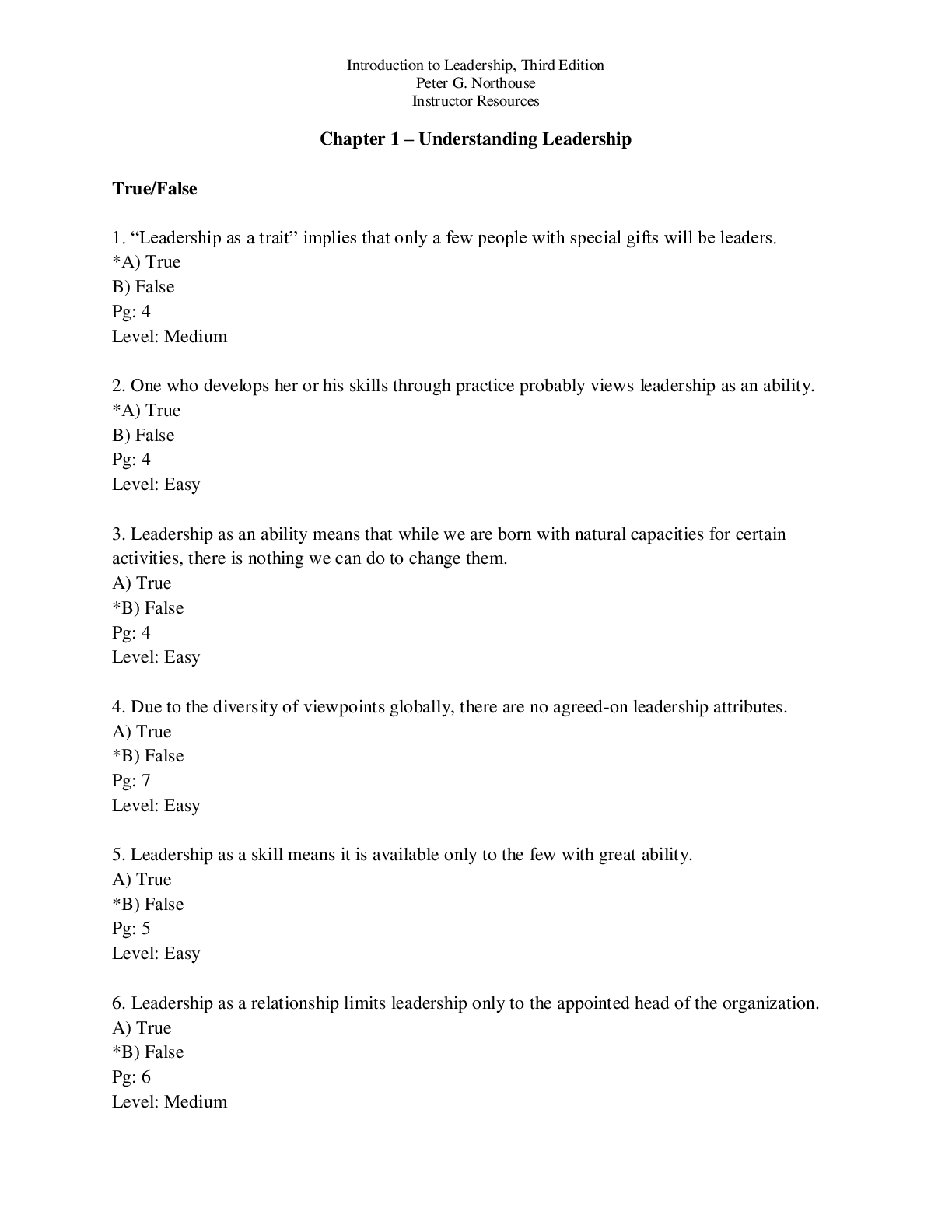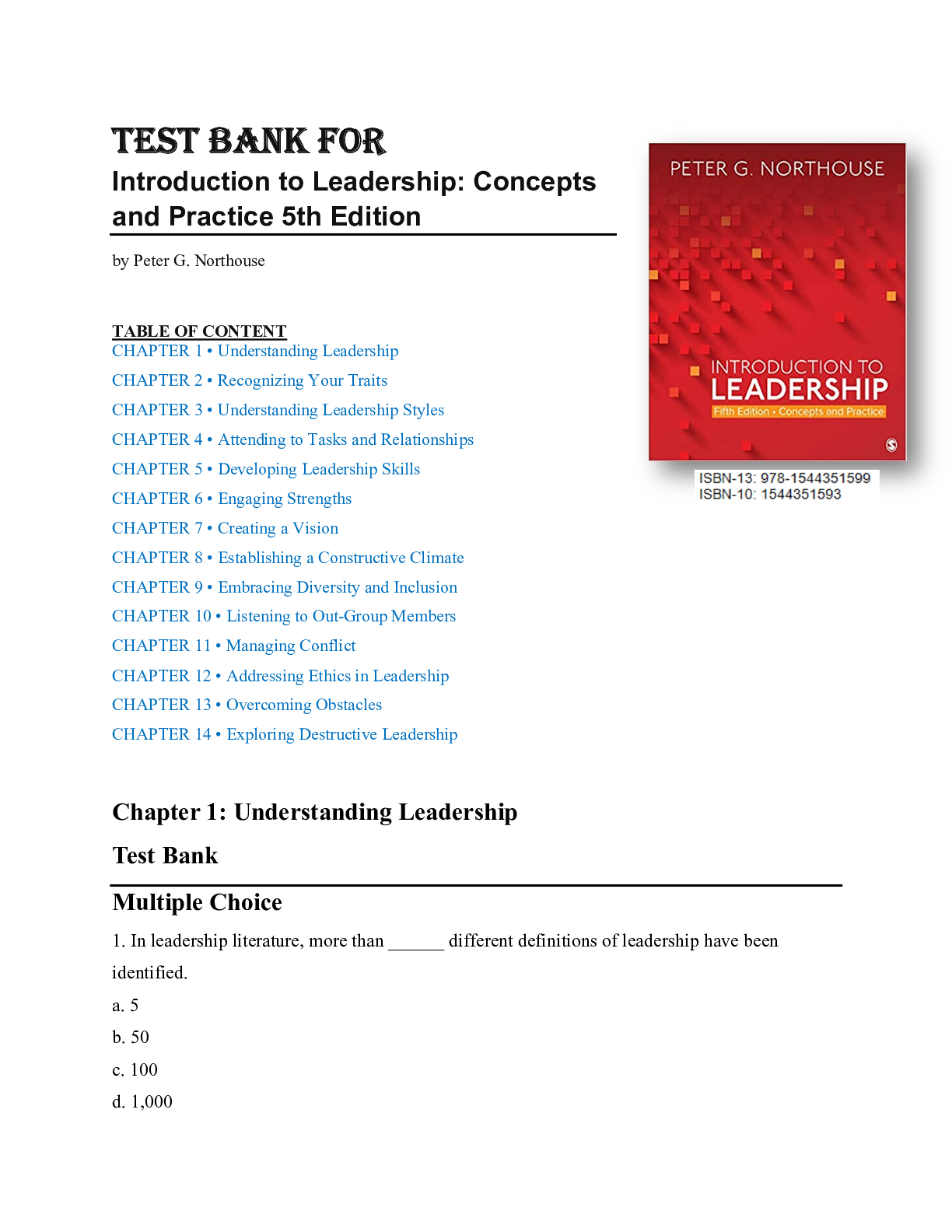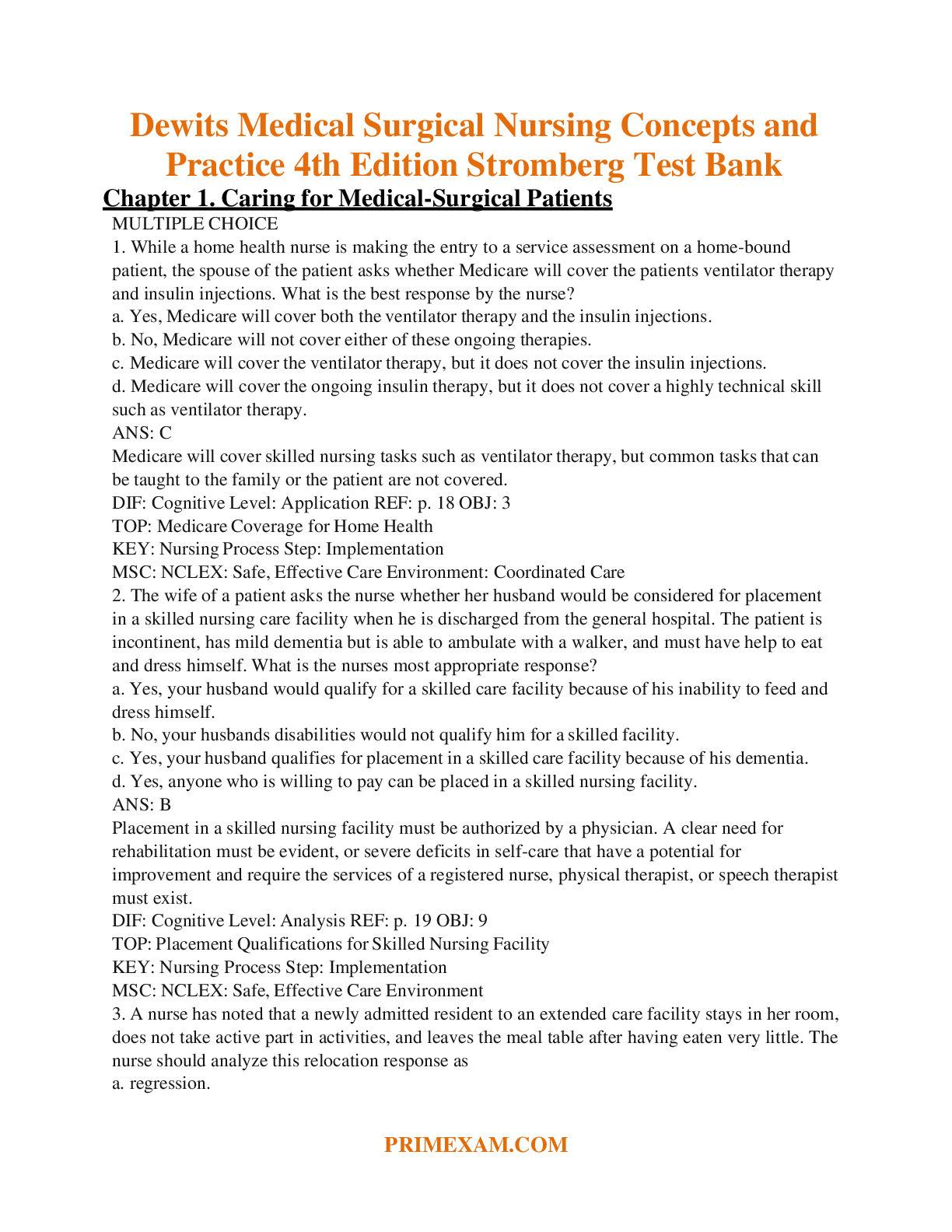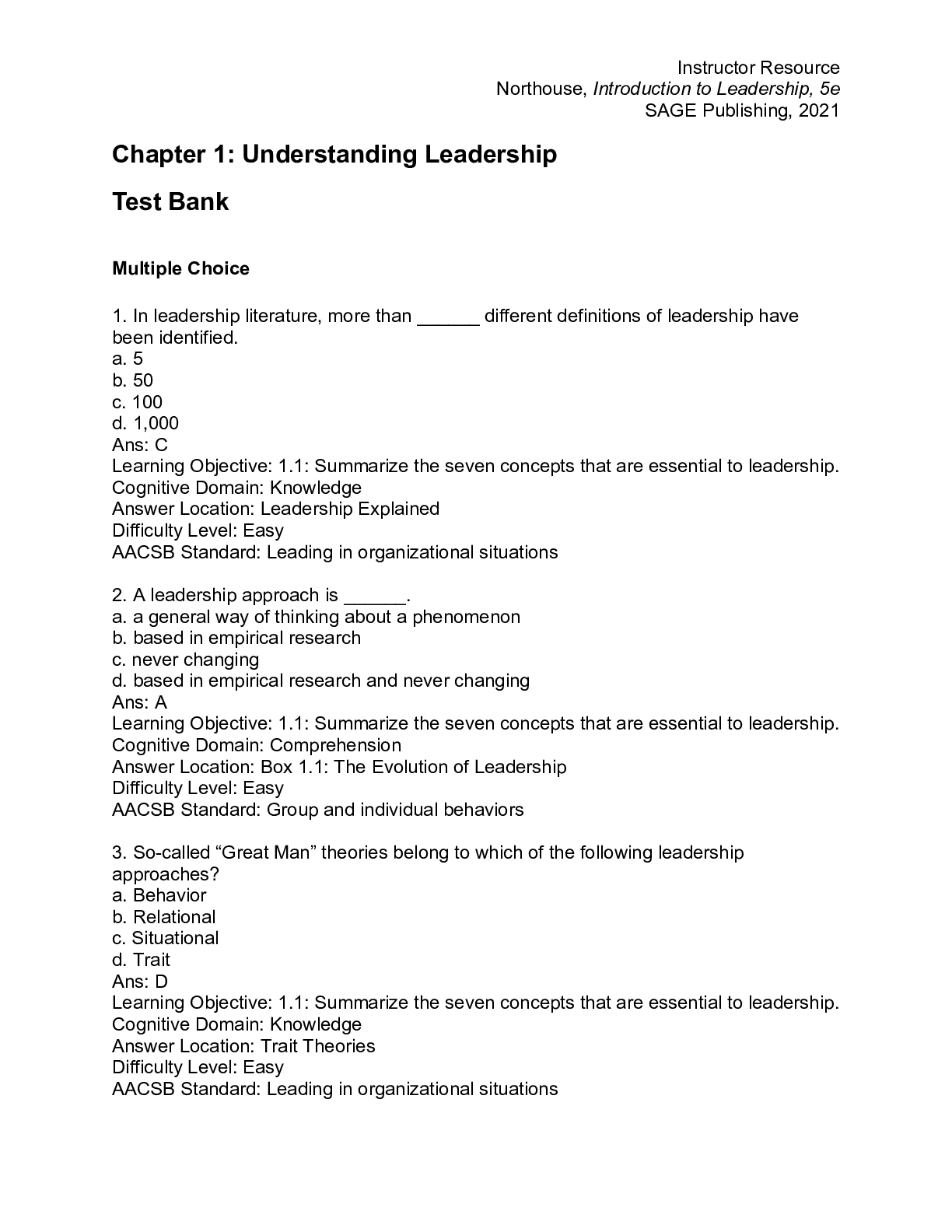*NURSING > TEST BANK > Medical-Surgical Nursing- Concepts and Practice Test Bank (Already Graded A+) (All)
Medical-Surgical Nursing- Concepts and Practice Test Bank (Already Graded A+)
Document Content and Description Below
Chapter 01: Caring for Medical-Surgical Patients deWit: Medical-Surgical Nursing: Concepts & Practice, 3rd Edition MULTIPLE CHOICE 1. Which statement accurately describes the primary purpose of the... state nurse practice act (NPA)? a. To test and license LPN/LVNs. b. To define the scope of LPN/LVN practice. c. To improve the quality of care provided by the LPN/LVN. d. To limit the LPN/LVN employment placement. ANS: B While improving quality of care provided by the LPN/LVN may be a result of the NPA, the primary purpose of the NPA of each state defines the scope of nursing practice in that state. PTS: 1 DIF: Cognitive Level: Comprehension REF: 2 OBJ: 3 TOP: NPA KEY: Nursing Process Step: Implementation MSC: NCLEX: Safe, Effective Care Environment: Coordinated Care 2. The charge nurse asks the new vocational nurse to start an intravenous infusion, a skill that the vocational nurse has not been taught during her educational program. How should the vocational nurse respond? a. Ask a more experienced nurse to demonstrate the procedure. b. Look up the procedure in the procedure manual. c. Attempt to perform the procedure with supervision. d. Inform the charge nurse of her lack of training in this procedure. ANS: D The charge nurse should be informed of the lack of training to perform the procedure, and the vocational nurse should seek further training to gain proficiency. Although the other options might be helpful, they are not safe. PTS: 1 DIF: Cognitive Level: Application REF: 3 OBJ: 1 TOP: Providing Safe Care KEY: Nursing Process Step: N/A MSC: NCLEX: Safe, Effective Care Environment: Coordinated Care 3. Which patient statement indicates a need for further discharge teaching that the vocational nurse should address? a. “I have no idea of how this drug will affect me.” b. “Do you know if my physician is coming back today?” c. “Will my insurance pay for my stay?” d. “Am I going to have to go to a nursing home?” ANS: A Lack of knowledge at discharge about medication effects and side effects is a concern that should be addressed by the vocational nurse. The other concerns in the options are the responsibility of other departments to which the nurse might refer the patient. PTS: 1 DIF: Cognitive Level: Application REF: 2 OBJ: 1 TOP: Teaching KEY: Nursing Process Step: Implementation MSC: NCLEX: Safe, Effective Care Environment: Coordinated Care 4. According to most state NPAs, the vocational nurse acting as charge nurse in a long-term care facility acts in which capacity? a. Working under direct supervision of an RN on the unit b. Working with the RN in the building c. Working under general supervision by the RN available on site or by phone d. Working as an independent vocational nurse ANS: C The vocational nurse in the capacity of the charge nurse in a long-term care facility acts with the general supervision of an RN available on site or by phone. PTS: 1 DIF: Cognitive Level: Comprehension REF: 2 OBJ: 1 TOP: Charge Nurse/Manager KEY: Nursing Process Step: N/A MSC: NCLEX: Safe, Effective Care Environment: Coordinated Care 5. The nurse is educating a patient that is a member of a health maintenance organization (HMO). Which information should the nurse include? a. Seek the opinion of an alternate health care provider. b. Obtain insurance approval for medical services prior to treatment. c. Provide detailed documentation of all care received for his condition. d. Wait at least 6 months to see a specialist. ANS: B Most HMOs require preprocedure authorization for treatment. Patients are not required to seek a second opinion, provide documentation of care, or wait a specific time period before visiting a specialist. PTS: 1 DIF: Cognitive Level: Application REF: 9 OBJ: 9 TOP: Charge Nurse/Manager KEY: Nursing Process Step: Implementation MSC: NCLEX: Safe, Effective Care Environment: Coordinated Care 6. The patient complains to the nurse that he is confused about his “deductible” that he owes the hospital. Which statement accurately explains a deductible? a. An amount of money put aside for the payment of future medical bills b. A one-time fee for service c. An amount of money deducted from the bill by the insurance company d. An annual amount of money the patient must pay out-of-pocket for medical care ANS: D The deductible is the annual amount the insured must pay out-of-pocket prior to the insurance company assuming the cost. This practice improves the profit of the insurance company. PTS: 1 DIF: Cognitive Level: Comprehension REF: 7 OBJ: 9 TOP: Health Care Financing KEY: Nursing Process Step: Implementation MSC: NCLEX: Safe, Effective Care Environment: Coordinated Care 7. The nurse compares the characteristics of a health maintenance organization (HMO) and a preferred provider organization (PPO). Which information should the nurse include about HMOs? a. HMOs require a set fee of each member monthly. b. HMOs allow the member to select his health care provider. c. HMOs permit admission to any facility the member prefers. d. HMOs offer unlimited diagnostic tests and treatments. ANS: A HMOs require a set fee from each member monthly (capitation). The patient will be treated by the HMO staff in HMO-approved facilities. Excessive use of diagnostic tests and treatments is discouraged by the HMO. PTS: 1 DIF: Cognitive Level: Application REF: 9 OBJ: 9 TOP: Managed Care KEY: Nursing Process Step: Implementation MSC: NCLEX: Safe, Effective Care Environment: Coordinated Care 8. A patient asks the nurse what Medicare Part A covers. Which response is correct? a. Medicare Part A covers inpatient hospital costs. b. Medicare Part A covers reimbursement to the physician. c. Medicare Part A covers outpatient hospital services. d. Medicare Part A covers ambulance transportation. ANS: A Medicare Part A covers inpatient hospital expenses, drugs, x-rays, laboratory work, and intensive care. Medicare Part B pays the physician, ambulance transport, and outpatient services. PTS: 1 DIF: Cognitive Level: Comprehension REF: 7, Box 1-4 OBJ: 9 TOP: Government-Sponsored Health Insurance KEY: Nursing Process Step: Implementation MSC: NCLEX: Safe, Effective Care Environment: Coordinated Care 9. Which is the main cost-containment component of diagnosis-related groups (DRGs)? a. Hospitals focus only on the specific diagnosis. b. Hospitals treat and discharge patients quickly. c. Reduced cost drugs are ordered for specific diagnoses. d. Diagnostic group classification streamlines care. ANS: B DRGs are a prospective payment plan in which hospitals receive a flat fee for each patient’s diagnostic category regardless of the length of time in the hospital. If hospitals can treat and discharge patients before the allotted time, hospitals get to keep the excess payment; cost is contained, and the patient is discharged sooner. PTS: 1 DIF: Cognitive Level: Comprehension REF: 8 OBJ: 9 TOP: Government-Sponsored Health Insurance KEY: Nursing Process Step: Implementation MSC: NCLEX: Safe, Effective Care Environment: Coordinated Care 10. The nurse is assessing a group of patients. Which patient would most likely qualify for Medicaid? a. A 35-year-old unemployed single mother with diabetes b. A 70-year-old Medicare recipient with retirement income who needs to be in a long-term care facility c. An 80-year-old blind woman living in her own home who has inadequate private insurance d. A 67-year-old stroke victim with Medicare Part A and an income from investments ANS: A Medicaid is a joint effort of federal and state governments geared primarily for low-income people with no insurance. PTS: 1 DIF: Cognitive Level: Application REF: 8, Box 1-5 OBJ: 9 TOP: Government-Sponsored Health Insurance–Medicaid KEY: Nursing Process Step: Assessment MSC: NCLEX: Safe, Effective Care Environment: Coordinated Care 11. Which area is the major focus of Healthy People 2020 and the primary mechanism through which to improve the health of Americans in the second decade of the century? a. Research funding b. Health information distribution c. Healthy lifestyle encouragement d. Health improvement program designs ANS: C Healthy People 2020 focuses on expanding ongoing programs to include support and information to reduce infant mortality, cancer, cardiovascular disease, and HIV/AIDS, and to increase effective immunizations, healthy eating habits, and healthy weight. PTS: 1 DIF: Cognitive Level: Comprehension REF: 6 OBJ: 7 TOP: Healthy People 2020 KEY: Nursing Process Step: Implementation MSC: NCLEX: Safe, Effective Care Environment: Coordinated Care 12. Which term explains the type of care that addresses interventions for all dimensions of a patient’s life? a. Focused care b. General care c. Directed care d. Holistic care ANS: D Holistic care addresses the physiologic, psychological, social, cultural, and spiritual needs of the patient. PTS: 1 DIF: Cognitive Level: Comprehension REF: 6 OBJ: 8 TOP: Holistic Care KEY: Nursing Process Step: Planning MSC: NCLEX: Psychosocial Integrity: Coping and Adaptation 13. A patient furiously says, “My doctor was so busy giving me instructions that he didn’t hear what I was trying to ask him!” Which response is most empathetic? a. “When people ignore me, I really get mad.” b. “I’m sure that the doctor was rushed and unaware of your needs.” c. “I’ll bet that made you feel very frustrated.” d. “Take a deep breath and plan what you will say to him tomorrow.” ANS: C Empathy demonstrates that the nurse perceives the patient’s feelings but does not share the emotion. Belittling the patient’s feelings, showing sympathy, or defending the doctor makes the patient feel devalued. PTS: 1 DIF: Cognitive Level: Analysis REF: 10 OBJ: 10 TOP: Nurse–Patient Relationship KEY: Nursing Process Step: Implementation MSC: NCLEX: Psychosocial Integrity 14. The nurse is explaining differences in a therapeutic relationship and a social relationship to a patient. Which information about therapeutic relationships is most important for the nurse to include in the explanation? a. Therapeutic relationships lack formal boundaries. b. Therapeutic relationships are goal directed. c. Therapeutic relationships meet the needs of each person in the relationship. d. Therapeutic relationships extend past the hospitalization period. ANS: B The therapeutic relationship is focused on the patient and is goal directed and designed to meet only the needs of the patient and does not extend past the period of hospitalization. PTS: 1 DIF: Cognitive Level: Comprehension REF: 9 OBJ: 10 TOP: Therapeutic Relationship KEY: Nursing Process Step: Implementation MSC: NCLEX: Psychosocial Integrity 15. The long-term care facility nurse is caring for a newly admitted 80-year-old patient who is depressed. Which approach is best for the nurse to employ? a. Encourage the resident to engage in an activity. b. Remind the resident of reasons to be positive. c. Point out episodes of negative behavior. d. Present a bright and cheerful behavior. [Show More]
Last updated: 1 year ago
Preview 1 out of 367 pages
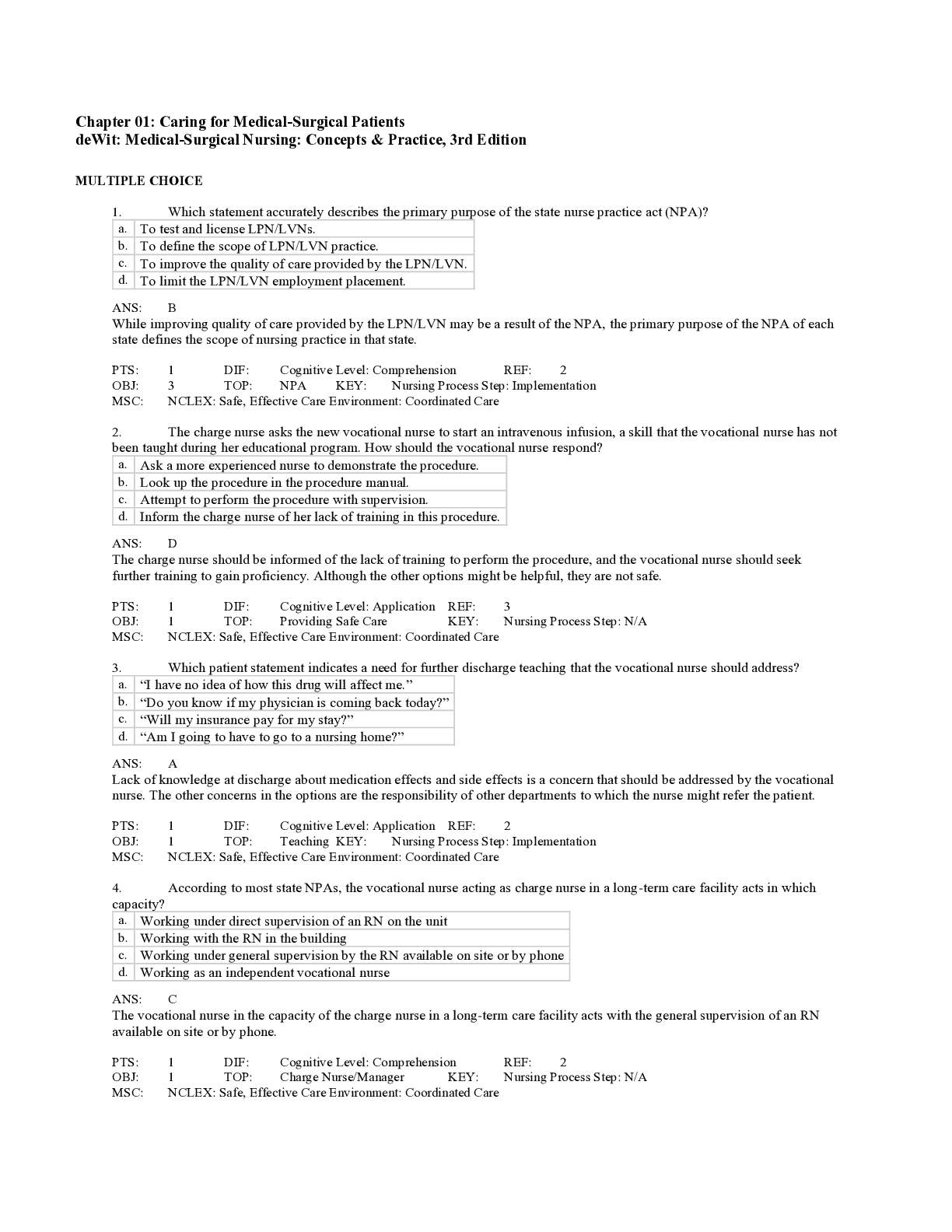
Reviews( 0 )
Document information
Connected school, study & course
About the document
Uploaded On
Sep 02, 2021
Number of pages
367
Written in
Additional information
This document has been written for:
Uploaded
Sep 02, 2021
Downloads
0
Views
69


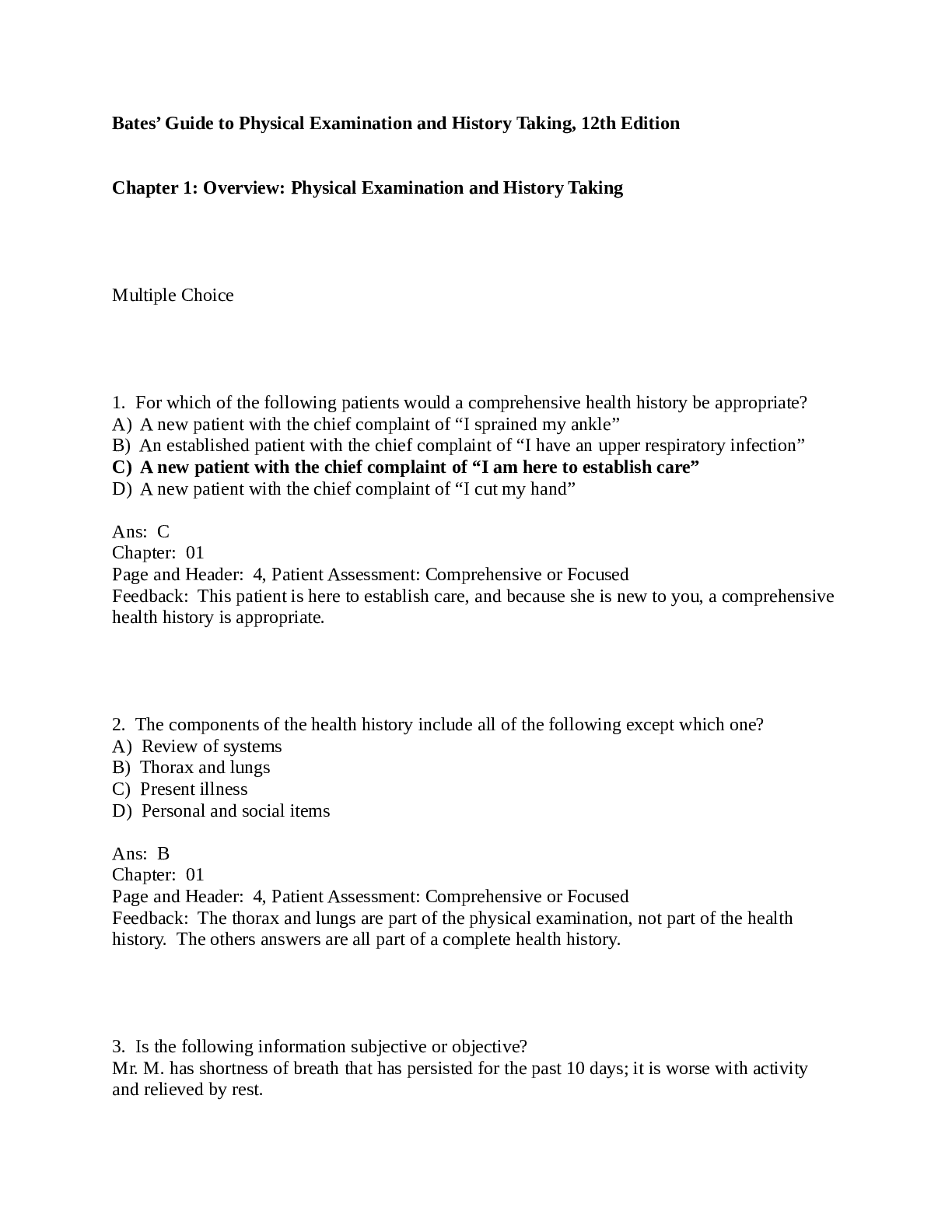
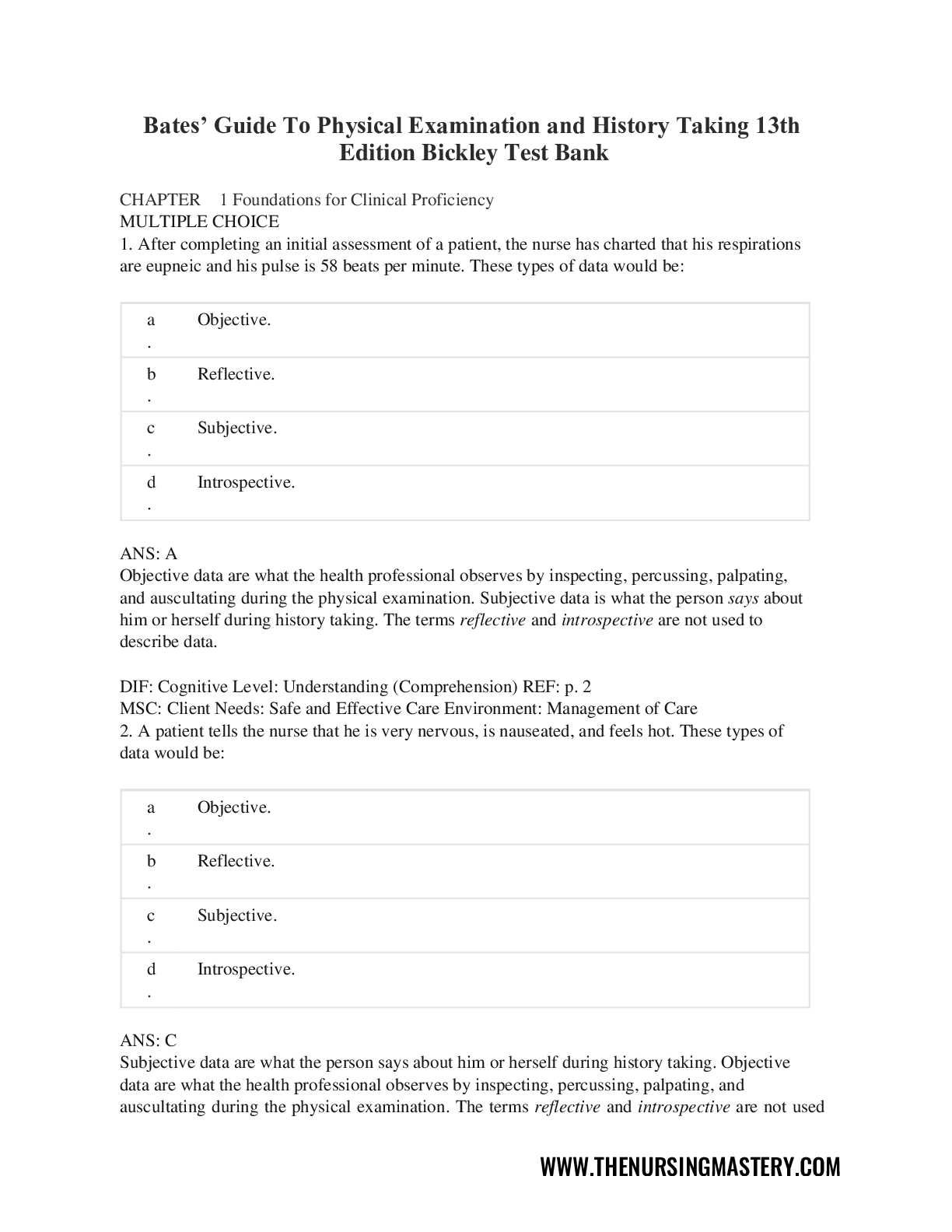
.png)
.png)
.png)

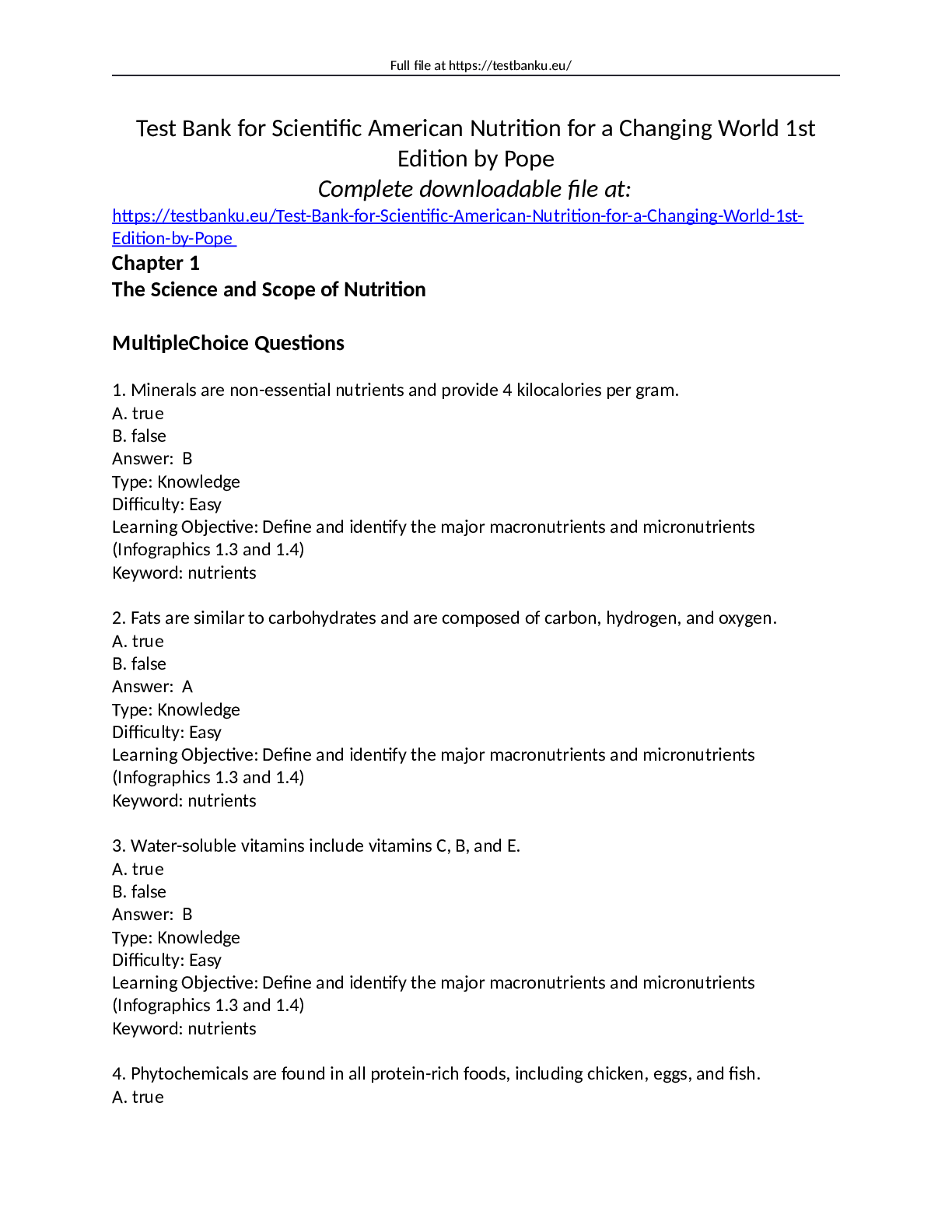
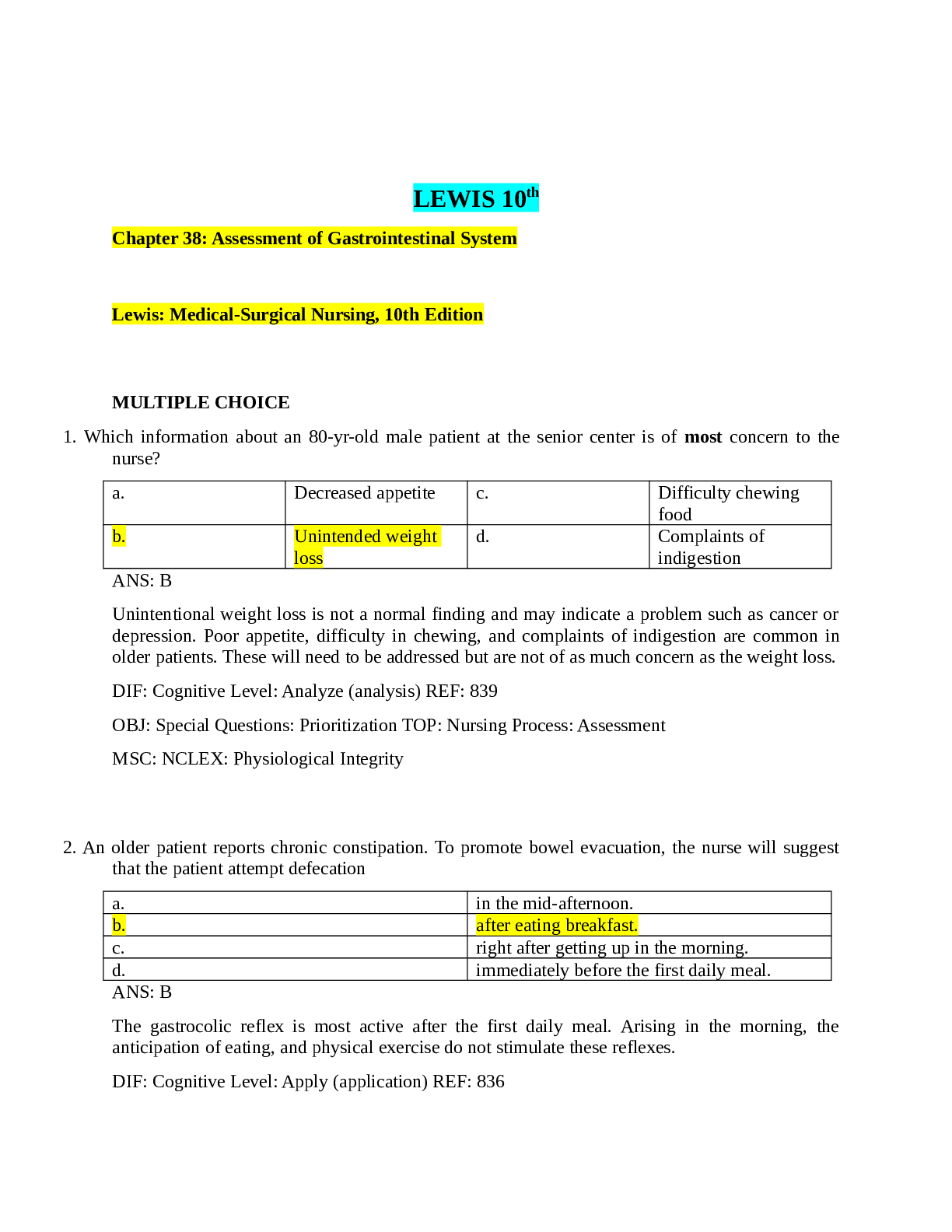

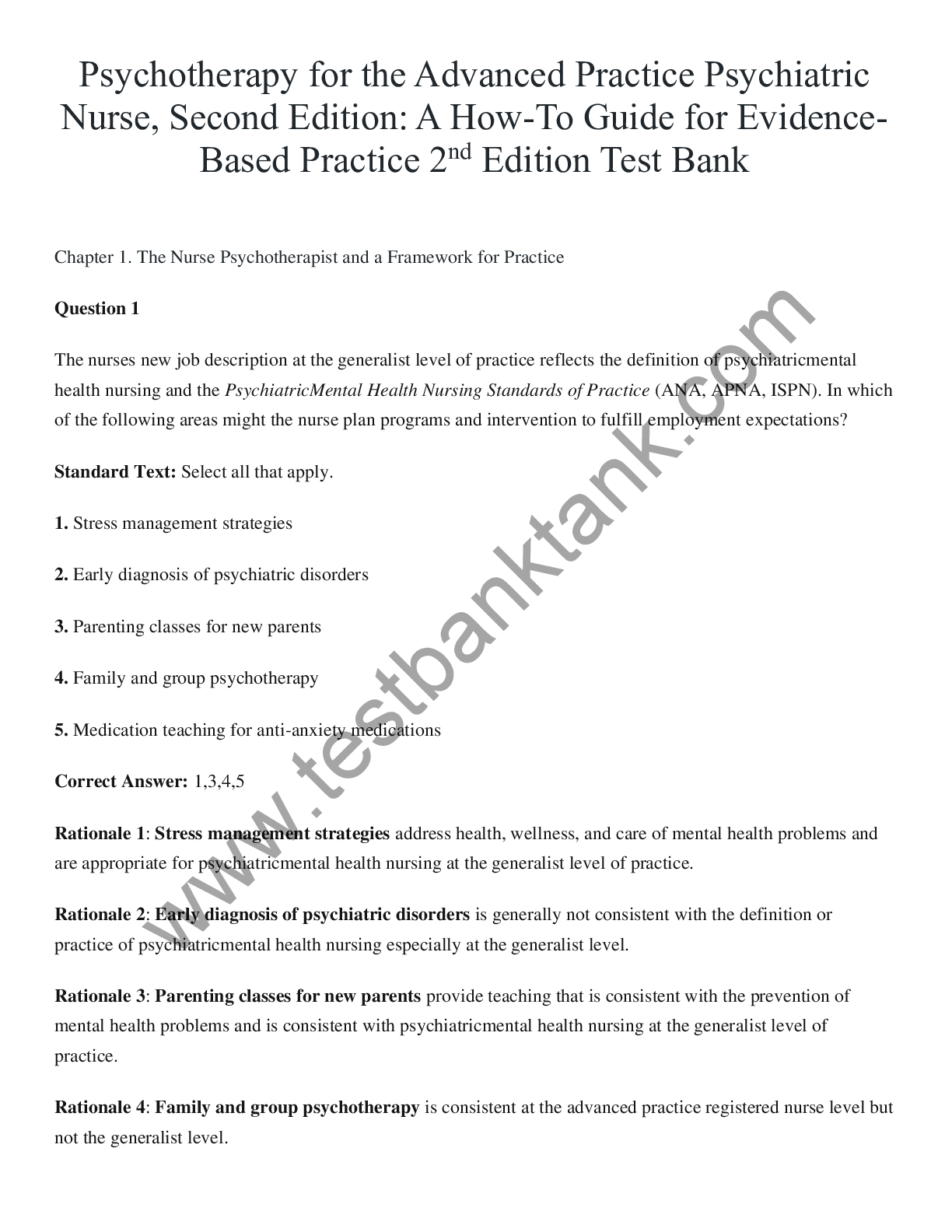
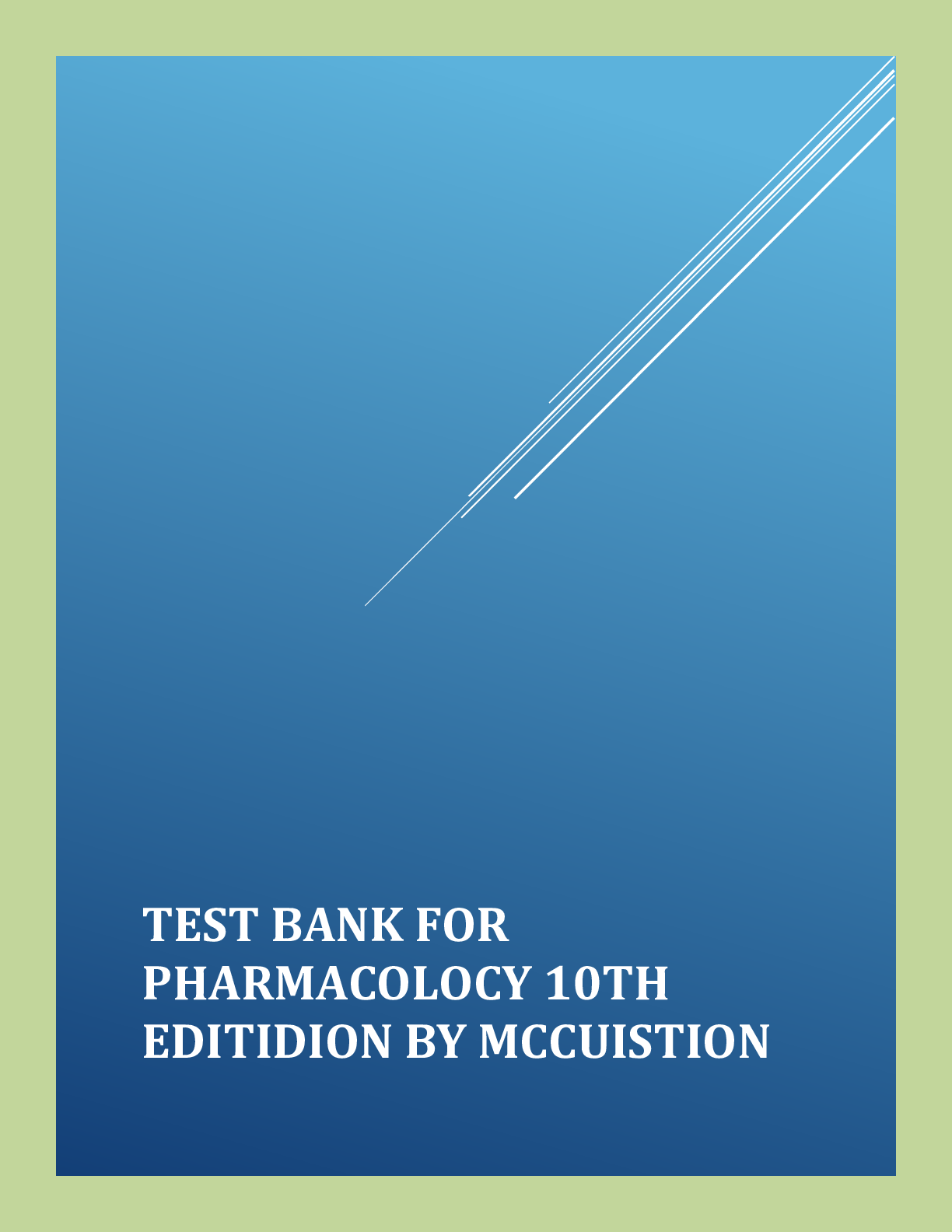
.png)

